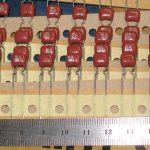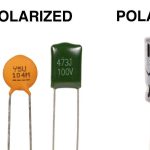These are the miscellaneous capacitors that are named after the dielectric materials used. This group includes Mica Capacitors, Air Capacitors, Vacuum Capacitors and Glass Capacitors etc.
Mica Capacitors
The Mica Capacitors are made by using thin Mica sheets as dielectric materials. Just like paper capacitors, thin metal sheets are sandwiched with mica sheets in between. Finally the layers of metal sheets are connected at both ends and two leads are formed. Then the whole assembly is enclosed in plastic Bakelite capsule. The following image shows how a Mica capacitor looks like.

Mica Capacitors are available in the range of 50pF to 500pF. The Mica capacitors have high working voltage up to 500volts. These are most commonly used capacitors for electronic circuits such as ripple filters, Resonant circuits, Coupling circuits and high power, high current RF broadcast transmitters.
Air Capacitors
The Air Capacitors are the ones with air as dielectric. The simplest air capacitors are the ones with conducting plates having air in between. This construction is exactly the same as the variable tuning capacitordiscussed above. These capacitors can be fixed and variable also but fixed are very rarely used as there are others with superior characteristics.
Vacuum Capacitors
The Vacuum Capacitors uses high vacuum as dielectric instead of air or some other material. These are also available in fixed and variable modes. The construction of these capacitors is similar to vacuum tubes. They are mostly seen in the form of a glass cylinder which contain inter-meshed concentric cylinders.
The following image shows a variable vacuum capacitor.

The following image shows how a fixed vacuum capacitor looks like −

Variable vacuum capacitors are available at a range of 12pF to 5000pF and they are used for high voltage applications such as 5kV to 60kV. They are used in main equipment such as high power broadcast transmitters, RF amplifiers and large antenna tuners.
Glass Capacitors
Glass capacitors are very exclusive ones with many advantages and applications. As all of the above types, here glass is the dielectric substance. Along with glass dielectric, Aluminum electrodes are also present in these capacitors. Plastic encapsulation is done after taking out the leads. The leads can be axial leads or tubular leads.

There are many advantages of a glass capacitor such as −
- The temperature coefficient is low.
- These are Noise-free capacitors.
- They produce high quality output with low loss.
- They have the capability of handling high operating temperatures.
- These capacitors can handle large RF currents.
There are many applications for these glass capacitors such as −
- Used in circuits that need to be at high temperature zones.
- Used in circuits that need high Q.
- Used in high power handling circuits.
- Used for circuits that need high tolerances.



Comments are closed